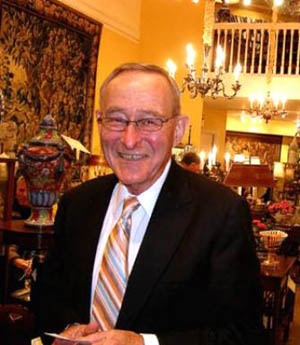 Tom in his shop
Tom in his shop
California:- October 4th - 20th, 2006
 Tom in his shop
Tom in his shop
October 4, San Francisco . Tom Livingston & Karel
Wessels. We
met Tom in Ghana, 1961, when he was a Peace Corps volunteer teaching at a
secondary school. A few years later Tom taught in the Department of Education
at UC Berkeley, leaving that post to set up his own antique shop in San
Francisco. Tom met Karel in Amsterdam in 1977, since when they have shared
their lives. Tom met me at the airport, and drove me - in his open top BMW - to
his shop in downtown San Francisco. After showing me their shop, Tom and I had lunch at a good quiet French
restaurant L. Olivier, with a bottle of Cotes
du Rhone. We later went to their elegant 1920s flat overlooking Lake
Merritt in Oakland, furnished - as you would expect in the home of antique
dealers - in an attractive and eclectic
(American, European, African and Asian) mix of exquisite furniture, paintings
and objets. It was like a small museum, but comfortable, not daunting. The
other inhabitant of the flat was Baukje, a strawberry Siamese cat, very
beautiful and extremely friendly. Not having had my daily exercise, I walked
the three miles around the Lake, sociologically and visually interesting.
The
next day Tom and Karel were both busy, so I travelled with Tom on BART (the Bay
Area Rapid Transit System, which had just opened when I was last in the Bay
Area) alighting at Powell, in “The City”, and finding a bus (as a senior I paid
only 50¢) to the De Young Museum in Golden Gate Park. I was happier with the
19th century American painters like George Caleb Bingham than with the more
contemporary exhibits, but the newly remodelled museum is a delight, and, -
like the Victoria and Albert Museum in London - has an excellent cafe. Back in
Oakland, my glasses needed adjusting, and I found a young Asian optometrist who
quickly fixed them. (Wandering around
San Francisco, I had noticed the significantly larger proportion of Asians in
the City than there were 20 years ago.) When I asked about payment he said “ no
charge, you are a visitor. Where are you from?” I was proud again to say that I
am from South Africa. After watching the excellent PBS news - much superior,
with its extended commentaries, than anything produced in Britain or South
Africa - we had dinner, with a Californian Pinot
Noir which Tom told me cost only $5 at Trader Joe's - which is the wine
merchant of choice for many. Trader Joe’s Two
Buck Chuck, Charles Shaw’s everyday red or white, selling at $1.99, is
claimed to be “the nation’s best selling wine” – and is certainly eminently
drinkable.
October 6/8. Watsonville,
California. Manuel and Ann Carlos. Tom drove me to San Francisco airport where I
boarded the “Santa Cruz Airporter” (the driver, to my relief, playing classical
music). Manuel, recently retired as Dean at Califronia State University
Monterey, met me. We had been
colleagues in the Department of anthropology at UCSB for more than 20 years;
Bernard and I always enjoyed the jolly parties at the Carlos's home where we
got to know their three bright and likeable children, Andrea, Lisa, and Roberto
(“Berto”). Manuel and Ann live on a lovely estate which had belonged to Ann's
grandfather. Daughter Lisa and her family live in the big house, built in 1909,
M & A in a smaller cottage , with two other properties on the estate.
Manuel took me on a tour to see the extensive work he had done on the garden. I
was not surprised to see banks of fuchsia, which he had always grown very
successfully, in Santa Barbara. There were also roses, tuberous begonias, New
Guinea giant impatiens, one redwood tree and two Chinese redwoods. The whole
estate is laid out in a series of attractive paths with vistas over the
countryside below. I even saw the amazing hummingbirds, which I had last seen
in Santa Barbara 17 years previously.
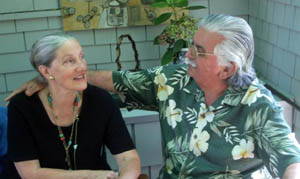
Ann
& Manuel
M
& A spend part of the year in Mexico where they have organised a turtle
project, AmaMexico, the aim of which
is to protect the baby turtles so that they survive and are not taken by local
people to eat. (I was proud to be invited to be on the board of this worthwhile
project).
On
Saturday we had breakfast (huevos
rancheros for me) at Seascape resort, overlooking a wide sandy beach on the
Pacific. Sitting on the terrace, it was chilly enough for us to be glad when
the waiter brought an overhead heater (Perhaps we should have thought of the
energy we were consuming?)
Driving
back past apple orchards, Manuel told me that the ranchers could not find
workers to pick the fruit, because the legislation for migrant workers had
stalled in Congress. I was reminded of the debates about the Bracero programme when I was doing
fieldwork with Mexican farm-workers in 1964. I saw impressive stands of
redwoods in the hills.
That evening we were joined by Berto, whom I had not
seen since he was a small boy, and his wife Nadia. I was much gratified that
all three children remembered Bernard and me fondly, and greeted me warmly,
making me feel quite at home; they are a handsome and a gracious family. At
dinner that evening we were joined by Andrea and Bruce and their three children
and we enjoyed excellent artichokes, not surprising as Watsonville claims to be
“the artichoke capital of the world”. During my stay, M & A and I had many
quiet conversations: this was a constant and appealing feature of my travels -
my friends and I always had much to talk about, and think about. On the Sunday
Manuel drove me to Mass, where genial Father Murphy, on being told that I was
from South Africa, asked me if I had met his friend the Irish ambassador to
South Africa: I had not. The Mass was one of the best in my travels, with good
participation from the friendly congregation. Manuel reminded me that we had
last been at Mass together at Tenancingo, Mexico, 1975, when a very different
sort of priest fiercely harangued us. After enjoying Manuel's tasty omelette on
the terrace, I accompanied him to Watsonville to buy supplies for the afternoon
party - we needed ice; wine; limes, Triple
Sec and Patron tequila (the best) for Manuel’s famous Margaritas. We were joined in the early
afternoon by the guests and also by M & A’s second daughter, Lisa, her
husband Brett and their two children. There was room on the wide veranda for
all of us to sit around the table, enjoying our snacks and drinks, overlooking
the gardens and taking walks to see various features which Manuel described.
All the guests were interesting and well-informed people. I got on particularly well with Rosario, a
bilingual educator from Bolivia. Then it was time for a nightcap of green tea
and an early night.
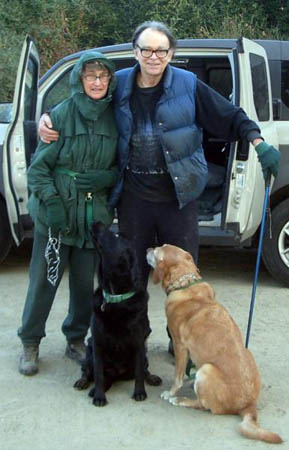 Molly, Ted & labradors
Molly, Ted & labradors
9th October-12. Altadena
California. Ted and Molly Scudder . I returned to San Francisco airport for the short
flight to Los Angeles. Flying over Mount Tamalpais (the highest point in the
county) I remembered the several
occasions when we had been there, once after JFK's assassination in November
1963, when we sought a quiet place to reflect. The aircraft turned, affording
me a great view of the ever-majestic Golden Gate Bridge, almost obscured by sea
fog.
Ted
did his first major field work among the Gwembe Tonga in the 1950s, in what was
then Northern Rhodesia (Zambia). This was a period when the Kariba dam was
under construction on the Zambezi River, resulting in the relocation of
thousands of the Gwembe Tonga. Ted and his colleague Elizabeth Colson have
studied the effect of this resettlement right up to the present, and Ted is now
the acknowledged world expert on involuntary relocation as a result of dam
construction. (This is not on a small scale: China’s Three Gorges Dam caused
the resettlement of 1 & 1/2 million people.) I became interested in this problem
in 1961 with the resettlement due to the construction of the Volta dam in
Ghana. Our shared interests brought us together, with our first meeting in
Berkeley in 1965. Our joint directorships of the Institute for Development
Anthropology (see Horowitz , Sept 20/21) created another strong link. Ted, who
recently retired from a professorship at the California Institute for
Technology, stayed several times with us in Cape Town when he was a member of
the World Commission on dams. Ted and I read each other's drafts and we discuss
almost anything. Molly is much respected for her successful personal tutoring
of children with problems. I had last seen her in 1998, when – at the annual
meeting of the Society for Applied Anthropology in Tucson, Arizona – I, on behalf
of the Royal Anthropological Institute, presented Ted with the first Lucy Mair
Medal for applied anthropology.
T
and M have lived for nearly 40 years in Altadena, in a lovely rambling old home
overlooking the canyon. With their interest in wildlife and in birds, Ted
having seen 50 species in the garden, this is a miniature nature reserve.
We
had our gin-and-tonics on the terrace, at dusk, followed by a roast turkey
dinner and later we watched the feeders just below us, where Ted had put out
water and dog food . We observed four racoons for 45 minutes; the following
evening we saw a fox as well as the racoons. T & M are early risers (5a.m.)
so we all went to bed early, which suited me well.
At
dawn the next morning we set off for their regular hour’s walk in the canyon,
accompanied by Belinda and Mwindi, their well-trained and affectionate
Labradors. At Ted’s Caltech office he found and lent me a number of IDA
documents which I need for my proposed history of IDA. Then we went to
Huntington Gardens, a few miles away in San Marino, to see the extraordinary
collection of South African cactus as well as the Japanese and Chinese gardens;
Ted was excited to see a flock of new birds, which he later identified as red
whiskered bulbuls, natives of south-east Asia which were obviously escapes. We
went on to the Huntingdon Art Gallery whose collection includes Lawrence’s Pinkie and Gainsborough’s Blue Boy, some very good Constables and
more than we could comfortably see in a short visit.
Our next morning walk lasted four hours,
covering Arroyo Seco and La Prieta canyons ; it was challenging for me and also
rewarding in terms of the varied scenery. Along the way Ted interspersed his
astute ecological and sociological observations on southern California with an
account of his current work in Laos, where he is one of three “Panel of
Experts” advising on resettlement . Ted regards this project as a model, in
that his panel has the power, for the first time, to enforce its
recommendations. Ted, always bubbling over with innovative ideas, suggested
that I combine an account of my travels with a network analysis, which I would
like to do. He is a good listener, as well as a clear and forceful expositor.
Our last dinner was not on the terrace, but at the President Thai restaurant .
Anne & Ron
|
October 12/13 Los Angeles.
Ron and Anne Mellor.
When
I was in London (see Aug.16)
Anne-Marie urged me to contact R and A, as we had all worked together on the
Education Abroad Program in UK in 1984/85. They both teach at UCLA, Ron in
Roman history and Anne in English and Gender Studies. Ted arranged for a car
to drive me to Mandeville Canyon Road, on the western outskirts of Los
Angeles, to have lunch with R and A. Bernard and I had visited them when they
were just moving in, since then some alterations have been made, resulting in
large rooms flowing into each other in a comfortable modern style, with
bookshelves everywhere. Although we had less than two hours together - Anne
had to leave to give a lecture - it was good to catch up and to learn how
their son Blake, whom I remembered as a schoolboy, is now married and a
professor of mathematics.
|
October 12/13. Ojai. Clive
and Marion Leeman. Shortly after I joined the faculty at UCSB in 1966, I was approached
by Clive Leeman who was writing a doctoral dissertation on Peter Abraham, the
South African coloured writer. Clive complained that no-one in the English
department knew anything about South Africa and asked me if I would be on his
dissertation committee. Because the University of California is relatively
flexible, I was formally appointed, finding it an interesting experience, and
making new friendships with my English colleagues. When we met C and M , their two sons, Philip and Thomas, were
little boys aged four and two: now they are both teaching, and married with
small children of their own. Bernard and I visited the family in 1980 in
Manzini when Clive was teaching at the University of Swaziland
.
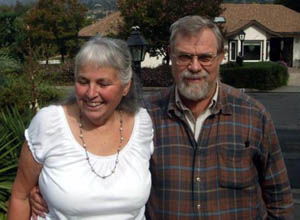 Marion & Clive
Marion & Clive
Clive
kindly drove (two hours) to meet me and take me to their home in Taormina Road,
Ojai (When they moved to this address, Clive surprised me by saying that I was
the only one who commented on the connection between Taormina and DH Lawrence).
On our journey Clive, who has always been on the radical margins, stopped at a CITGO petrol station,
explaining that Venezuelan oil was sold there. But after President Chavez’s
remark at the UN, I smell sulphur (referring to President Bush) a few days earlier, CITGO had threatened to
cancel the contract.
I
am familiar with the attractive small town of Ojai because we often drove there (less than an hour from Santa
Barbara) to see Clive and Marion and to experience the warm hospitality of
Marion's father, Dr. Jerome Rupp, a
much loved local physician, and his wife , also named Marion. (It was Clive who
put us in touch with his twin brother Kevin in London - see Sept 13/14. Clive
and Kevin had also attended Durban High School, albeit some twenty years after
me).
On
the following morning, Marion took me for a walk around neighbouring Krotono,
where the Institute of the Theosophical Society is based, with overtones of
Krishnamurti and Madam Blavatsky. I spent less than 24 hours with them, but
again we used the time well, restoring and strengthening the links between us.
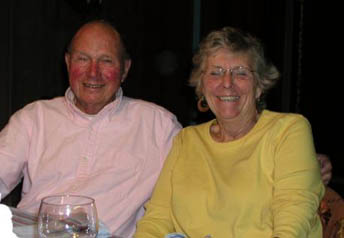 DWB & Barbara
DWB & Barbara
October 13/16. Santa
Barbara. Don and Carrie Brown and the Anthropologists. I taught in the Department
of Anthropology at UCSB from 1966 until I retired in 1989. I was chairman in
the troubled period (Vietnam War protests) of 1968/70, during which our
beleaguered faculty was very united. Barbara
Voorhies had come out of retirement to become Chair for the second time.
When she learnt that I would be in California this year, Barbara arranged a
lunch, so that I could meet my former colleagues, nearly all of whom are now
retired. I stayed with Don and Carrie, who hosted a lunch at their lovely
hillside home near the San Marcos Pass road, overlooking the Californian live
oaks on the mountains behind. They also invited me to stay in their home. Their
daughter, Rosminah, had stayed with us in Sherborne when she was doing a
Horticultural Diploma at the Royal Botanic Gardens at Kew. She also spent some
time with us in Cape Town, in connection with her studies of Mediterranean type
flora.
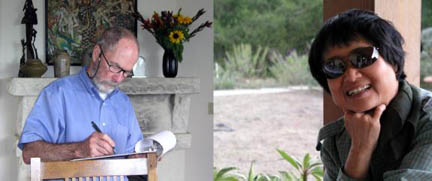
It
was a jolly lunch and a very significant occasion for me because I was
re-united with colleagues who had supported and collaborated with me; unlike
many contemporary departments of Anthropology, we had harmonious relationships
with each other. Don Brown reminded me that during my two years as chairman I
had hired him and four other faculty members, which I had quite forgotten.
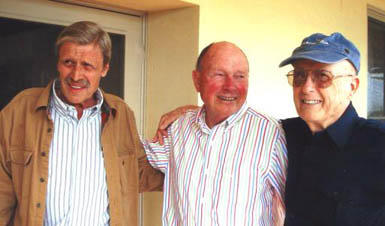
Those
present at the lunch included Charles Erasmus, who had been chairman in 1966,
and had hired me; Tom, who succeeded me as chairman, and Pat Harding, who had
driven up from Topanga Canyon; Mike and Marcia Joachim: Mike was chair when I
retired; Mike Glasgow and Annabel Ford, both archaeologists; Philip and Cynthia
Walker. Phil, a physical anthropologist, and I had co-taught a course on
“People and Animals”; Claudia Madsen, whose husband Bill had died not long ago.
(Claudia, always active in civic affairs, took the opportunity to collect our
signatures on a petition objecting to a proposed development). I was pleased
when the Browns insisted that Clive and Marion, who had driven me from Ojai,
should stay for lunch, which they did, getting on well with everybody – they
are articulate and passionate in conversation, but also good-natured. An
excellent lunch in all respects. I was sorry to miss two other colleagues, Don
Symons and Juan-Vicente Palerm, who were unable to come to the party.
Chuck
Erasmus collected me at 6.30 the next morning, taking me for breakfast
(pancakes, bacon and eggs) at Moby Dick's on the harbour. We passed the famous
Harbour Restaurant where Bernard and I liked to take our visitors - I remember
my brother Paul and his wife Jil much enjoying the bouillabaisse and the crayfish. Then we had a seven-mile walk first
to the East Beach (the scene of Kinsey Millhone's home in Sue Grafton’s series
of crime novels) and then all the way to the top of the hill at Shoreline Park
and back. Saturday-morning, with many walkers, some with dogs, cyclists, roller
skaters and all the beachside cafes were busy. Chuck, a year older than I, is
lean and fit, obviously used to exercise. We had a good talk on our long walk,
I enjoying, as ever, his absolute honesty and lack of any pretence. I learnt
that the median house price in Santa Barbara is $1.2 million - no wonder it is
difficult to hire new faculty as junior lecturers cannot afford to live
anywhere near the university. I was glad when Chuck told me how remarkably
knowledgeable and helpful Bernard had been, when working at UCSB library.
Then
Rosminah drove me in her new Toyota Prius, a hybrid automobile, of which there
are many in California. We collected Pat
Griffith she and I going to Zookers in Carpinteria for lunch, (shrimp and
scallop burrito with black beans and avocado salad accompanied by a Sauvignon Blanc from Monterey Martin
winery). Our pleasant waitress, learning that I was from South Africa,
questioned me closely about river trips on the Zambezi River, which she and her
husband hope to do.
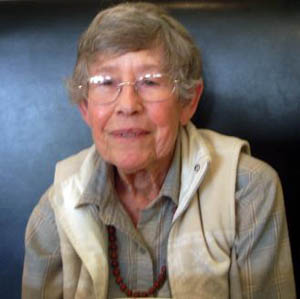 Pat
Pat
Pat
was a secretary in the Department of Anthropology when we first met in 1966,
and then she was administrator of a research institute which I directed from
1975/82. Pat was wonderful to work with, unfailingly cheerful, good with both
students and faculty, seemingly having time for everyone, yet carrying out her
work efficiently and without fuss. She
was always interested in what Bernard and I were doing - and reading . We
shared many cultural interests, and we have remained close friends. Pat is a
regular correspondent, writing hand-written letters full of the most
interesting material. Although she has had various illnesses, she remains
resolutely cheerful and excellent company.
On
the Sunday morning, Carrie drove me to Mass at the Old (1786) Santa Barbara
Mission. When we lived in Santa Barbara I preferred the more modest Our Lady of
Guadalupe church, which was nearer our home and where the congregation was more
diverse. However, this was a pleasant service and Carrie told me that she was
“glad of a quiet time”.
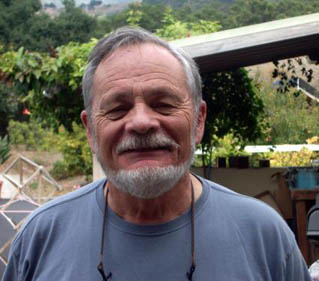 Brian
Brian
My
archaeology colleague Brian Fagan had been unable to attend the lunch so he collected me on Sunday morning to go
downtown for coffee. Brian retired in 2003 after 36 years in the Department. He
has always been hyper-active - as an innovative and popular lecturer (not only
at university, but also on cruise ships), and as the author of a series of well
received books, based at first on archaeology, but later covering climate,
famine and on his other major interest
– sailing and the oceans. It was a
refreshing and stimulating short meeting. Many American departments of
Anthropology are bitterly divided, so much so that several universities,
including UC Berkeley, Harvard, Stanford and Duke, have established two
separate departments. According to Don Brown, the division is between the post-modernists
“who do not believe in objectivity” and the “scientists”. Barbara said it was
partly based on the old “nature vs nurture” debate. Whatever the cause, the
arguments have been destructive and have resulted in bitter feuds at many
universities, including UCSB. I
remembered how Chuck Erasmus had firmly established a policy of tolerance -
whatever our theoretical differences we did not allow these to affect our
students or our relationships with each other. Barbara had left the Department
12 years ago and was brought back to sort it out: if anybody can do it, it is
Barbara, who is a skilled administrator, liked and respected by all.
That
evening, Barbara took me to Pat Griffith’s home, driving along the back roads,
past our old home on Loma Media which had been “improved” – I would say
“ruined” - by unsightly additions. I much preferred our modest house, ideal for
entertaining, and with extensive views, where we lived for 23 years. Pat’s son Jack and his companion Toby had driven up from L.A to prepare a dinner for
us. Jack, a restauranteur, and Toby, a successful animator, have been together
for 40 years, and Bernard and I had enjoyed their company on many happy
occasions (including sometimes at Thanksgiving and Christmas) at Champs d’Elysees, as Pat’s home is
known.

October 16/18. Bakersfield.
Lanys & Graham Kaye- Eddie. The efficient Carrie Brown found that there was a
6:10am Amtrak bus from Santa Barbara, all the way to Bakersfield for only $17,
which gave me an enjoyable journey along familiar territory, first running
alongside the Pacific Ocean at dawn, then passing the huge orange and avocado
orchards and the strawberry fields; we stopped at Carpenteria, Ventura, Oxnard, Santa Paula, Filmore, then north
on Route 5 and Highway 99 to Bakersfield, the latter part nearly all semi-arid.
Graham
and Lanys , originally from southern Africa, have lived in California for over
40 years. Graham, an architect, designed our dream house in Santa Barbara in
1980 - a remarkably imaginative house which unfortunately was never built
because we moved to live in England. Lanys is a major breeder of Andalusian
horses, keeping about 25, mostly mares, on their 10 acre lot on the outskirts
of Bakersfield. Lanys phoned me shortly after Bernard's death and told me to
come to Sao Paulo, Brazil, - “you need a break” - to attend a wonderful horse auction which she and her
colleague, Paulo Gonzaga organised.
I
had visited L & G nearly 20 years ago when they were living in the country
but now the city surrounds them. They were good and informative guides as we
drove round the city. I went with Graham to the town of Wasco, which I knew
from Walter Goldschmidt's As you Sow,
a pioneering account, of farm-workers in the 1930s.
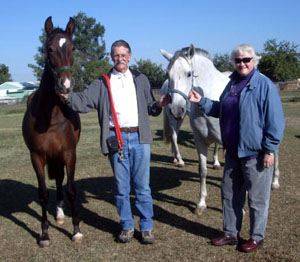 Graham & Lanys
Graham & Lanys
After
a visit to the huge futuristic COSTCO store, where everything, from peanut
butter to automobiles, seems to be available, we drove east into the granite
hills to call on their friend Marshall; he has a house on a lovely remote 40
acre plot, and proudly showed us holes in the rocks, made by Native Americans
for grinding corn. During my visit we had two good dinners, one at Benji’s Basque restaurant and one at Mauricio’s Mexican,where I enjoyed good Chile Rellenos and a Dos Equis beer. I did not see L &
G’s daughter, Emily, who lives near San Diego, but I did become friendly with
the three Kelpies, Matilda, Pancho and Chaka.
October 18/19. Los Angeles.
Ralph Lister.
Lanys drove me to Los Angeles, Ralph having e-mailed detailed “Map Quest”
directions to his apartment in Silver Lake. Ralph, 44 years old, is the
youngest son of Kim Lake and Julius Lister (see Aug. 21). He is an actor,
enjoying his stage parts in small theatres and making most of his income from
voice-overs, and television work. Knowing that Ralph was struggling, I almost
expected to find him living in a garret, but I was given a comfortable bed in
his study; he has a convenient modern flat, with a flat-mate to help pay the
rent.
Ralph
was interested in my memories of his father during our younger days; he
produced a tiny tape-recorder and I talked for must have been hours, both
before and after dinner.
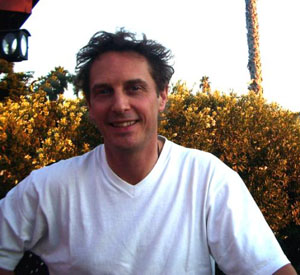 Ralph
Ralph
I
told Ralph about our student days …
Julius' relationship with his mother Nancy…. our travels to Germany, including
our epic canoe trip on the Rhine…Julius’ visit to me in Western Tanganyika,
when we went on an elephant hunt, and I reminded Ralph of our visit to the
family in Indonesia, when he was nine years old.
I
took Ralph to dinner at Yamashiro, the best Japanese restaurant
(serving “California Asian cuisine”) that I have known; situated way up in the
Hollywood Hills , we had a window seat with an expansive view of the city; we
were the last to leave at nearly midnight.
Early
the next morning I had an urban walk, exploring Sunset Boulevard, only a few
blocks away. Then Ralph drove me to LAX airport after my persuading him not to
be like his father who was always “a last minuter ”. Given the new security
regulations I like to allow plenty of time at airports these days.
October 19/20 (travelling westwards across
the dateline I gained a day). On the recommendation of Elspeth Jack's airline
executive nephew William, I had booked a seat in the top cabin of the Qantas
aircraft, giving myself maximum comfort for the long 13-hour flight to Sydney.
NEXT - Stage 6 Australia Oct 20 - Nov 2nd 2006